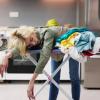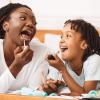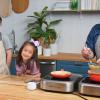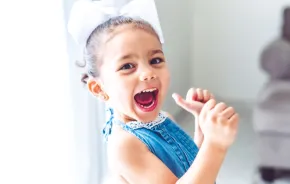 I knew I had settled into my summer vacation when I casually tossed my plastic bottle, food waste, and take-out box into the garbage without frantically looking for three bins to sort my recycling, compost, and trash. I was in a place that did not offer these choices.
I knew I had settled into my summer vacation when I casually tossed my plastic bottle, food waste, and take-out box into the garbage without frantically looking for three bins to sort my recycling, compost, and trash. I was in a place that did not offer these choices.
When I accepted the Styrofoam clamshell take-out box from the server, I looked guilty while choking back something like, "These have been banned for five years where I'm from!" Like many of us, I take for granted the bubble of environmental awareness in which we Puget Sounders live. It had become my lifestyle and I was relieved to get back to it after being away.
Immediately upon return to Washington, my two children and I were invited to explore the first exhibits of Hands On Children's Museum's Outdoor Discovery Center, a half-acre of space designed to reconnect children to nature in Olympia. When we arrived, we had to use the bathroom; that's when I knew I was back home in the Pacific Northwest. The museum's commitment to sustainability starts with the building: Hands On re-opened in a brand-new 28,000 square-foot LEED-certified building in November 2012. Among other cutting-edge environmental features, the building captures waste methane gas to heat and cool the museum. In the bathroom, the sign read, "Our toilets use reclaimed water."
I'd heard of reclaimed wood and the use of gray water systems, but reclaimed water was new to me and about to make a big impact.
Genevieve Chan, museum communications manager, introduced us to the museum and the exhibit we were there to see. "The goal of the Outdoor Discovery Center is to reconnect children with nature, get them moving, digging, exploring and learning in an exciting, engaging setting that is reflective of the beautiful Pacific Northwest," she said. The museum believes free play is a powerful way to develop kids' brains and builds the critical cognitive function known as executive decision.
The Outdoor Discovery Center is the first of its kind in our region and one of only three "Going Wild" pilot program sites selected by the Association of Children’s Museums nationwide. Over the next two years, the Center will develop more than ten exhibits. As planned, families will wander through winding paths of native plantings, over boulders and under bridges that lead to places for making mud pies, discovering dinosaur bones or climbing a 20-foot-high lighthouse.
We headed outside to explore one of the center's first exhibits, a walk-through sculpture titled "Stickworks" by renowned artist Patrick Dougherty. As we approached the installation, I felt giddy with surprise. I have been a fan of the work of Dougherty — who has created hundreds of installations around the world using locally gathered saplings — since art school, but I purposely went to the museum blindly, without researching beforehand. As I stood in awe and delight, my children rushed inside of the installation. It was raining lightly. My body relaxed and my heart opened to this new experience. They were about to play as they wished, inside something handmade by one of my favorite artists.
They ran through the shady retreat called "Creative Cursive," hiding in its nooks and crannies. My 6-year-old squealed with glee when she tried to follow her little brother through a secret doorway fit just for him but had to drop to her knees to crawl through. As I touched the arching, woven branches, with my hands, I felt captivated by the constant swirl of lines surrounding my vision in this magical grove. However, it was the smell within that engulfed my senses. Enchantment smells like hundreds of freshly cut vine maple saplings or a forest after it rains.
I could have stayed there for hours and wished I had more time to let my children get "lost" inside of it. Before we left, I called Genevieve in her office to ask to take a few photos, but I really wanted to say, "Can we please go into the sculpture again so I can smell it?" "Stickworks" will remain in place for about three years. The colors of the branches will change from green to brown to gray before it degrades and is disassembled. This fascinating video shows the work in progress and this video gives a glimpse into Patrick Dougherty's work.
When it is gone, another installation will take its place by an artist that also works with natural materials. Remember when we were kids, when we could ride our bikes, catch critters, climb trees, and explore the wild places around our neighborhoods for hours? Being inside that sculpture brought me back to the experience of being little again in one of my favorite hideaways, which is the intention of Patrick Dougherty's work and the vision behind the Outdoor Discovery Center.
"I want to show you our stream," said Chan. At the mention of it, my children perked up and chased us to it. "The stream" is a free water feature open to the public that gives the public the opportunity to learn about water reclamation and water preservation before even entering the museum. Located in the park plaza in front of the museum, and managed in partnership with the LOTT Clean Water Alliance, it's a babbling brook filled with two dozen bronze sculptures, mosaics, tracks and fossils that flows for more than 250 feet. Its features mimic a natural stream and wetland, and is fed by Class A reclaimed water – water that has been used, cleaned, disinfected, and is ready to be used again, just like the natural water cycle! The stream is the first reclaimed water feature in the state of Washington officially approved for play – so you can kick off your shoes and socks and wade.
As I sat beside the stream, the sun broke through the clouds. My children not only kicked off their shoes, but also threw them into the bubbling water to chase them downstream, under a bridge, around intermittent sprays and over rocks. There are few uncontaminated streams in our city where they can play; this was a rare moment. As my children enacted experiments of cause and effect, I read the museum's brochure: "Children, on average, spend less than 30 minutes a week in outdoor, unstructured play. We want to change that."
Since then, I've been thinking about the term "outdoor unstructured play." Wasn't this once commonplace for every child? Has it now become a privilege? I remember when Chan cited research that free outdoor play can develop your brain and build executive function. Does this mean self-control can be improved with a prescription of more nature, more outdoor, unstructured play? If it will help, I'll try it.
In the next two year, the Outdoor Discovery Center will be in full swing. Kids can already play in the Driftwood Fort construction area, which allows families to build forts out of local driftwood pieces.
Eventulally, children will be able to clamber on a life-size tugboat and mama and baby orca whale sculptures, dig in the sand in a Puget Sound Beach Replica exhibit and make mud pies. Adults and children alike will able to ride giant trikes in the Trike-and-Hike Loop and to witness things growing in the Rain Garden and Children's Garden. In the Naturalist's Cabin, there will be activities to learn more about animals and plants. Visitors will be able to add something to the Art Fence or stop by the Campfire Pit for s'mores or a story.
I could imagine myself as a single mom working full time and living in Olympia. I might pick my child up from aftercare at the end of a long school/work week and head out to a free Friday night at Hands On. We'll build a driftwood fort, race each other on trikes or pull veggies. These exhibits are stepping stones that inspire us to go to the real forests and beaches.
The Outdoor Discovery Center has taken a big barefoot step toward giving more children the opportunity to get wet and muddy. Be warned: you might need to bring an extra change of clothes during a visit here, but that might be just the thing needed towards making the world a better place for families.
 If you go ...
If you go ...
Where: Outdoor Discovery Center at the Hands On Children’s Museum, 414 Jefferson St N.E., Olympia, 360-956-0818
Hours: Monday–Saturday, 10 a.m.–5 p.m.; Sunday, 11 a.m.–5 p.m.
Admission: $9.95 general admission for age 2 and up; $7.95 seniors; $6.95 toddlers 12-23 months. Babies under 12 months free with paid admission. The water feature in front of the museum, the reclaimed-water stream, is free.
Deals: First Friday of the month is FREE from 5 p.m.-9 p.m.
Other attractions at the museum: Hands On is the largest children's museum in the Pacific Northwest, and boasts dozens of interactive, engaging indoor exhibits, from a two-story marine cargo ship to the Tide to Trees Climber and Slide, where children can imagine they’re a Pacific Northwest raindrop; to Build It, where kids can build with real-life tools. Read our review here.
The stream: The reclaimed-water stream in the East Bay Public Plaza is located at 325 Marine Drive in Olympia, Washington. The plaza is open every day from dawn to dusk; during the warmer months the stream runs daily, from 7 a.m.-5 p.m.; it is free.
Nearby attractions: If you have extra time, consider a visit to the LOTT Wet Science Center; Olympa's awesome farmers market, open Saturdays and Sundays in the winter; and Percival Landing, a waterfront park.
About the author: Jennifer made a promise to herself within this often wild and harried experience of being at home with two small children: She created lifelines in the form of writing, painting and photography. She never realized her art degree would be the thing that saved her as a mom. Her favorite days are spent riding around Seattle with her kids on her cargo bike and exploring habitats as a family at their favorite park. Her parents gave her the freedom to take hours of creative solitude to herself as a child, thereby teaching her that making things with your hands is honorable work and a fine way to support and love your family. She hopes she can do the same for her little ones. She recently decided to publish her writings long held private in journals. Visit her at Mermaid City.














